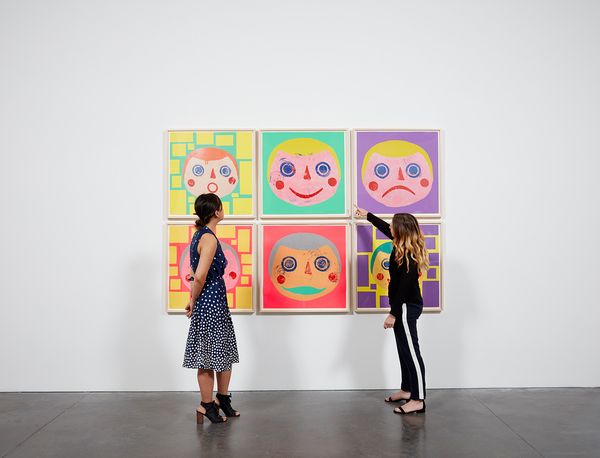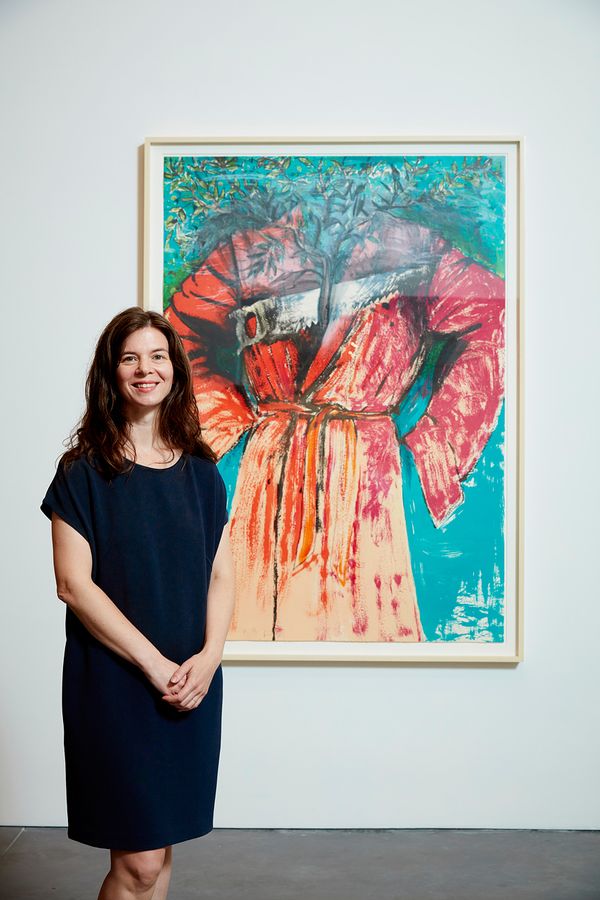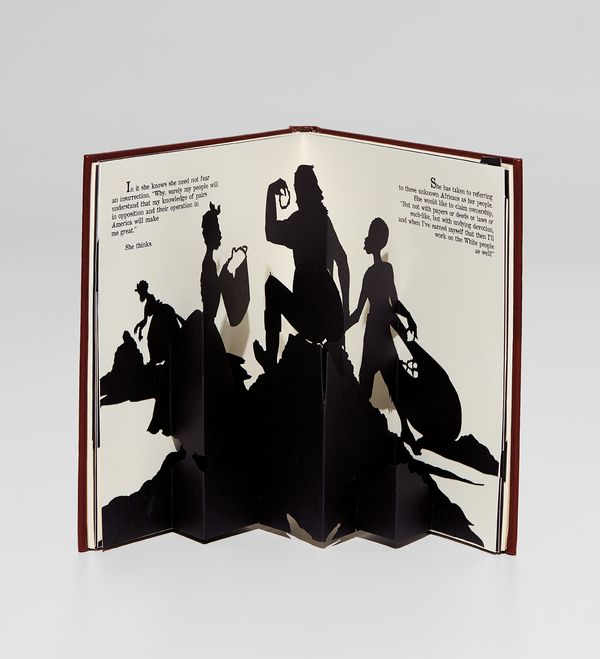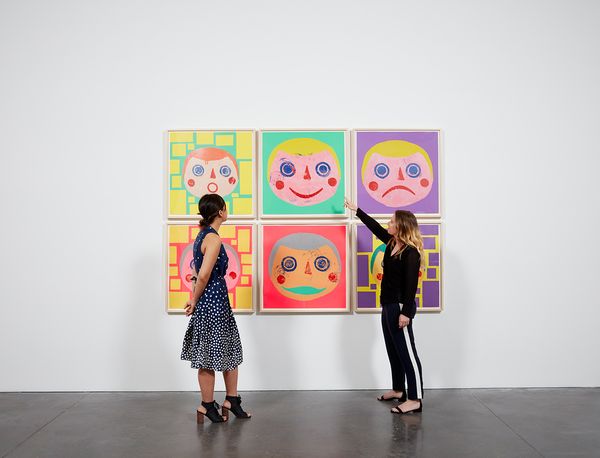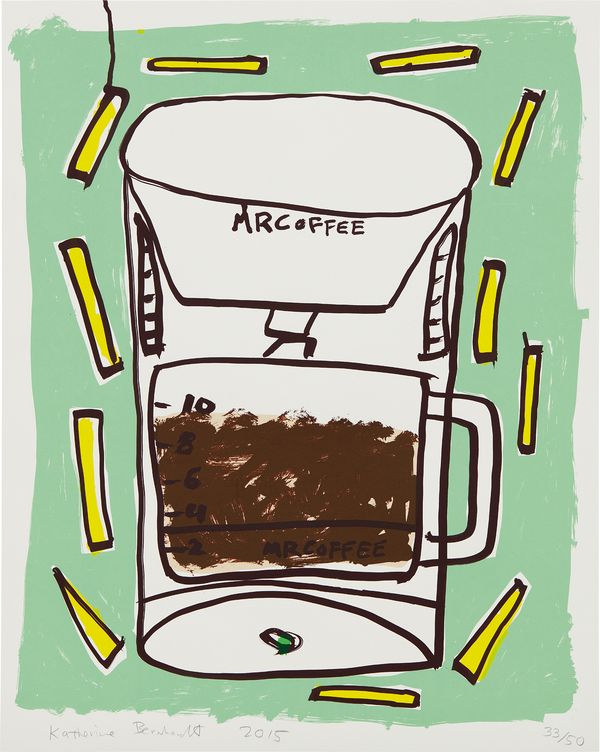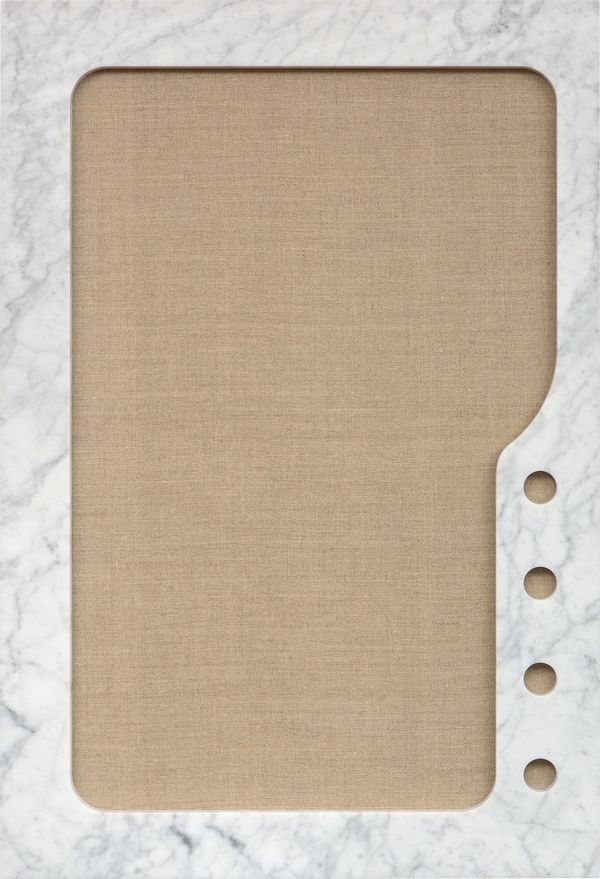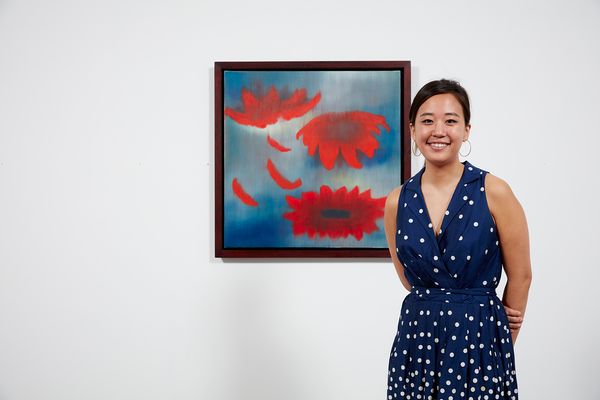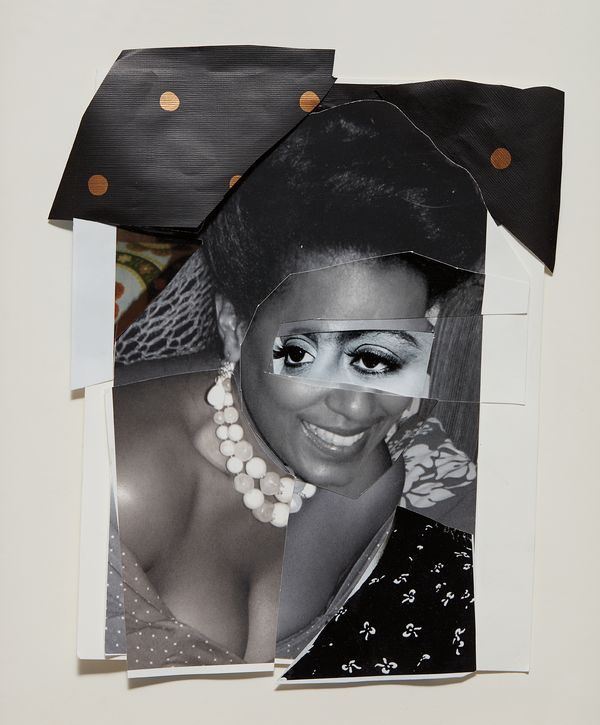Specialists Erin Kim (left) and Katherine Lukacher (right) in front of Donald Baechler Coney Island at Phillips New York
This summer, Phillips and Artsy are excited to co-present 'Summer School', a selection of accessible artworks for new and seasoned collectors with an emphasis on emerging contemporary art and editions by blue-chip names. Bidding is open exclusively online on Artsy through 25 July, so we took this opportunity to sit down with the specialists behind this tightly-curated sale.
Read on to discover their picks plus tips on navigating the art market and buying at auction.
Jannah Greenblatt
Specialist, Editions, Phillips
Featured Work: Jime Dine 'Atheism', 1986
Q: What would be some of your favorite picks in this sale — why are they perfect for a collector just starting out; what about these pieces makes them intriguing?
A: I find the pop-up book by Kara Walker very intriguing. There's something nice about literally having to hold the work of art in your hand to engage with it. I think the form really lends itself to her work, both the graphic silhouettes and her interest in cultural myth and storytelling. This was produced by the Peter Norton Christmas project and is from a large edition size; however the owner later asked the artist to sign this copy, which makes it special from others in the edition.
Kara Walker Freedom, A Fable, 1997
Q: Who is the first artist you collected? Who is on your personal wish list?
A: The first print I purchased was in 2010: Barbara Kruger's Your Right, which was a fundraiser for the EAB (Editions / Artists' Book Fair) Fair. At the time it was only $200, but we just sold another example from this edition at Phillips last season for $3,500!
Benefit prints are a great way to purchase works by big name artists, often for an attractive price, while supporting charitable organizations in the arts. Examples from this sale include the Jasper Johns print, which was originally a fundraiser for the senate campaign of Harvey Gannt, and the Katherine Bernhardt screenprint which was published to benefit NADA.
Q: What are some strategies you recommend for the new collector just beginning to dip into auctions?
A: I think it's important for collectors to take time to educate themselves on the market and previous auction results for works they are interested in. Thankfully, most information is available online, and there are now numerous resources including Phillips.com where you can browse our past results by artist or auction and follow artists to track when new works are offered. The advantage of collecting prints is that there is often auction history for an exact print to look to, and you have a wealth of accessibly priced works by established artists.
It's heartening to find contemporary artists engaging with traditional forms of printmaking, like intaglio or stone lithography.
Q: How do you find contemporary artists engaging with different forms of printmaking today?
A: It's heartening to find contemporary artists engaging with traditional forms of printmaking, like intaglio or stone lithography, perhaps as an antidote to the digital worlds we all navigate day to day. An example is the beautiful and intricate printmaking that Nicole Eisenman has been doing at Harlan & Weaver, using traditional intaglio methods on a copper plate. Harlan & Weaver is one of my favorite print studios; their prints always have a luminous jewel-like quality, even when working with diverse artists such as Louise Bourgeois or Richard Artschwager. It's fascinating to see the influence of the printer on the final works — it is truly a collaborative process, although the printer takes the supportive role to the vision of the artist.
Q: From Tom Wesselmann nudes and Jim Dine robes to Hunt Slonem bunnies and Tom Otterness bronzes, this sale is filled with prominent motifs of 20th century art. What are some of your favorite "icons" from the sale?
A: My favorite iconic work in the sale is Hollow Man Suite by Robert Motherwell. The images are beautifully stark and haunting, and explore the forms the artist engaged himself with throughout his career.
Katherine Lukacher (right)
Specialist, 20th Century & Contemporary Art, Phillips
Featured Work: Donald Baechler 'Coney Island', 1994
Q: What would be some of your favorite picks in this sale — why are they perfect for a collector just starting out; what about these pieces makes them intriguing?
A: I love the Katherine Bernhardt; it is a perfect example of her "pattern paintings" infused with the whimsy of a painted still life; it is iconic and yet, by being an edition, is the perfect price point for a beginning collector.
I also adore Analia Saban's Kohler 5931 Kitchen Sink #3. It is absolutely stunning, with its juxtaposition of taupe linen and naturally patterned marble; it is hypnotizing and innovative in form despite being created from art historically traditional materials. I think she is an artist who will continue to garner attention.
Katherine Bernhardt Mr. Coffee with Fries, 2015
Analia Saban Kohler 5931 Kitchen Sink #3, 2013
Q: Who is the first artist you collected? Who is on your personal wish list?
A: The first piece of art I purchased was a wall piece by Isaac Brest called Fan Out. It is made of paper, joint compound on sheetrock in a beautifully constructed wooden artist's frame. The piece hung in the back showroom of a gallery I worked at, and I saw it every day and decided I must have it. I bought it directly from Isaac and I absolutely still love it. It has a simplistic, natural look to it, lying visually at the art historical intersection of Donald Judd, Robert Ryman and Walter De Maria, and is physically located at the intersection between my living room and bedroom.
In an ideal collecting world I'd love a Donald Judd wooden Ballantine box, a Carl Andre poem, a Mitchell Wright monochrome, acrylic-on-panel painting and an Analia Saban Kitchen Sink painting.
Try to develop some kind of periphery to your overall aesthetic and then zoom in.
Q: Which emerging artists are you most excited about right now?
A: As an art historical researcher, I really like the re-emergence of artists who have been overlooked in their respective generations. Carmen Herrera, Carol Rama, Lee Morton...I think there are many more artists who may not be "contemporary" but are still very much being discovered.
Q: What are some strategies you recommend for the new collector just beginning to dip into auctions?
A: To go out to the auction previews and investigate what you are visually attracted to, asking yourself, 'why do you like it'? Try to develop some kind of periphery to your overall aesthetic and then zoom in. I know I like Minimalism aesthetically but really had to do some digging into why, and by doing that research, you begin to pull out even broader themes in your collecting which could span across different mediums, different genres and different art historical time periods but are all tied by a kind of innate comprehension of cultural significance.
Q: What mixed media works stand out to you in Summer School? How are emerging artists pushing the boundaries on different mediums right now?
A: I love the Tom Friedman sculpture — he has created a towering structure in line like many of his sculptural predecessors like Brancusi and Serra, but by constructing the sculpture from Styrofoam cups, he infused the gradiated form with a contemporary levity.
Erin Kim
Specialist, Artsy
Featured Work: Ross Bleckner 'Sky Flowers', 2004
Q: What would be some of your favorite picks in this sale — why are they perfect for a collector just starting out; what about these pieces makes them intriguing?
A: I've noticed that new collectors breaking into the art world tend to first go after high-quality works by established names in the market before expanding to more emerging artists. This strategy is understandable, as it feels safer; they want to invest in big names while continuing to hone their tastes and sensibilities as they visit more galleries and see more art.
With this in mind, one that I'd like to highlight is the multi-faceted work, Clarivel #1 by Mickalene Thomas. She's an internationally recognized artist whose work is held in many important collections; she is also an endlessly fascinating artist who draws from a multitude of art historical and contemporary pop-culture references, shedding light and challenging the traditional depictions of femininity and beauty.
Mickalene Thomas Clarivel #1, 2014
Q: Who is the first artist you collected? Who is on your personal wish list?
A: The first work that ever came into my possession was a lithograph by Ed Ruscha. It was gifted to me several years ago. As Jannah mentioned, prints are also a great way to begin collecting, and editioned works by blue-chip artists like Frank Stella, Tom Wesselmann and Donald Baechler are all within grasp without having to break the bank.
In an ideal world, there are several artists on my radar. A couple months after acquiring the Ruscha, I went ahead and bid on a work by Carrie Mae Weems from her 'Kitchen Table' series in an auction but was swiftly outbid. I've made sure to follow her on Artsy since then, so that I can receive notifications whenever a new work gets added by a gallery partner or is featured in an auction. I also came across a drawing by Agnes Martin called No Exit at a group show at Peter Blum Gallery. At first impression, it's a drawing of slightly irregular lines, with the white space on the sheet punctuated by dots made by pen. There's an absolute calmness and musicality in her drawings that evoke a sense of peace.
Q: Which emerging artists are you most excited about right now?
A: I first came across Ivana Bašić’s work at Spring/Break in 2016, then at the Whitney Museum's "Dreamlands" show and then once again at NADA this year. Her sculptures resemble the bruised and wounded flesh on bodies that is simultaneously fragile and resilient, propped up against harsh surfaces and structures. At first glance, I felt my reaction to be visceral, feeling both physically vulnerable and emotionally empathetic for her figures. It is a unique moment when an artwork can evoke such a strong reaction like that.
So many wide-ranging artists are fully embracing the limitless possibilities of medium and forms of expression available today; among them, I've recently seen Dan Herschlein, whose domestic interiors invoke psychic uneasiness, and Billie Zangewa, who creates silk tapestries with contemplative scenes of motherhood.
Do your market research beforehand...Treat this process as you would any big purchase.
Q: What are some strategies you recommend for the new collector just beginning to dip into auctions?
A: Set a maximum bid on the work, especially if it is a work that you feel you cannot miss out on. Maximum bids are honored on a first-come, first-serve basis. I also recommend "following" an artist on Artsy so you are among the first to know when a work is to be featured at auction!
Q: What is your #1 tip for someone just starting to buy at auction?
A: Do your market research beforehand; don't be afraid to ask the specialist any questions. Treat this process as you would any big purchase. Do your best to find what similar works are going for in the secondary market, and keep condition in mind. Once you have some comparables, then you can feel comfortable setting your maximum bid in order to budget for the piece.
Because of the instantaneous nature of auctions that enables bidders to passionately go after what they want, it always helps to be grounded in numbers and facts.
Q: What mixed media works stand out to you in Summer School? How are emerging artists pushing the boundaries on different mediums right now?
A: Similar to Kat, I find Analia Saban's juxtaposition of marble and linen in Kohler 5931 Kitchen Sink #3 to result in a work that is unexpected and elegant in its concept and manifestation. She's an artist who has consistently found ways to subvert the traditional, intended use and classification of such mediums for artistic production. We all know paint is traditionally two-dimensional, linen is the support structure and marble is carved into something three-dimensional, but Saban finds humorous and unexpected ways of toppling those notions.
Q: As a specialist at Artsy, can you elaborate on how the technological aspect of the business impacts your work and how you think about the market?
A: The art world moving online will greatly expand the existing market for buying and selling art. Technology has made collecting art that much easier in that now you can sign up for notifications by artist or auction. Going even further, Artsy serves as a digital repository of knowledge for the art world with exhibition history, auction results and relevant articles by artist, and that information will only grow over time.
The best art collecting starts with education and easier access to information.
